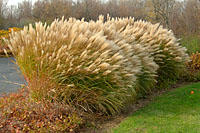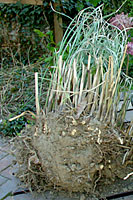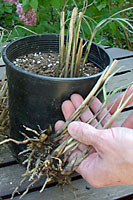Terry L. Ettinger Horticulture Consulting Services
Meeting The Needs Of Today With A Vision For The Future
Question of the Week
Dividing Ornamental Grasses
 Q. I have several clumps of maiden grass that are probably each two feet in diameter. I know they can be divided,
but I don't know how big the divisions need to be to survive? Also, is it already too late to divide them this year?
Q. I have several clumps of maiden grass that are probably each two feet in diameter. I know they can be divided,
but I don't know how big the divisions need to be to survive? Also, is it already too late to divide them this year?
A. There are many forms of Japanese Maiden Grass, all of which are members of the genus Miscanthus. Some of the more popular varieties include `Morning Light,' `Silver Feather,' `Zebrinus' (or Zebra grass), and `Strictus' (or Porcupine grass). They're among the largest ornamental grasses in Central New York landscapes and all can be divided throughout the growing season.
 The most common method of dividing ornamental grasses is to use a very sharp spade to split off large chunks from the edges
of well-established plants, at left. These large divisions, often six or more inches in diameter, will quickly grow into large plants.
However, the number of divisions you can make are limited. And, in some instances you run the risk of transporting unwanted
invaders to new locations in the soil taken with the divisions.
The most common method of dividing ornamental grasses is to use a very sharp spade to split off large chunks from the edges
of well-established plants, at left. These large divisions, often six or more inches in diameter, will quickly grow into large plants.
However, the number of divisions you can make are limited. And, in some instances you run the risk of transporting unwanted
invaders to new locations in the soil taken with the divisions.
 A second option to wash all the soil from a good-sized clump and break or cut off individual tillers that have formed roots,
at right.
These individual shoots can then be transplanted directly into new spots in your garden,
or potted up or "lined out" in a mini-nursery for a
year or two to gain size before transplanting to a permanent spot in your landscape.
A second option to wash all the soil from a good-sized clump and break or cut off individual tillers that have formed roots,
at right.
These individual shoots can then be transplanted directly into new spots in your garden,
or potted up or "lined out" in a mini-nursery for a
year or two to gain size before transplanting to a permanent spot in your landscape.
While the resulting plants from these tillers will be quite small, they offer a couple of advantages.
First, because there's no soil around the roots, you won't transport root pieces or seed of unwanted weeds to new locations in your garden. And, because the divisions are so small, you can create dozens of new plants from each established clump of grass in your garden.